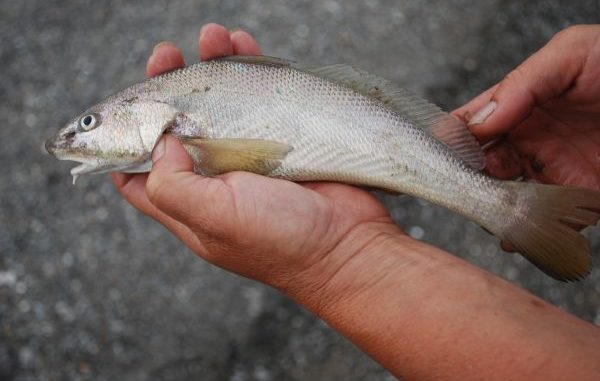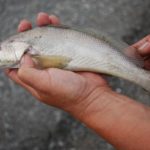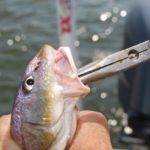
Kingfish better table fare than drum, trout
Biologists like writing about cool fish — odd fish, fish that are a swimming riddle. This month’s guy (or more properly “guys”) is that.
They are members of the most-popular family of sport fishes on our coast, yet few anglers know much about them. They are plentiful, but only occasionally caught. They taste great, but few recreational fishermen eat them.
Worst of all, we completely misname them, somewhat demeaningly, as “mullet.”
We are talking about commercial shrimpers’ universal favorite table fish — the channel mullet, also called ground mullet, black mullet or sea mullet.
This isn’t where the misnaming ends. Kingcroaker is sometimes heard, and so are a host of names that include the name “whiting:” southern whiting, king whiting, gulf whiting, beach whiting and just plain whiting.
Whiting, of course, belong to a completely different family, the cod family, and with one exception — the blue whiting (found in Canada, Greenland and Iceland) — they aren’t even found in North American waters.
If you are confused, that could be a good thing. It helps you understand why scientists use those tongue-twisting scientific names based primarily on Latin, a dead language.
A scientific name remains the same for a species the world over.
As mentioned, we are dealing with more than one species, three to be exact: southern kingfish, Menticirrhus americanus; gulf kingfish, Menticirrhus littoralis; and northern kingfish, Menticirrhus saxatilis.
Everyone except scientists and fish wonks lump them together as one.
The genus name for the fish, Menticirrhus, is derived from Latin. “Mentum” means “beard” or “chin” and “cirrus” means “curly.” The name obviously refers to the prominent beard-like barbells on their lower jaws.
Their species names are pretty straightforward: americanus means “american,” littoralis means “of the shore” and saxatilus means “dwelling among the rocks.”
The fish are members of the drum family — the family of redfish, speckled trout and croakers — but they bear no resemblance to their family-mates. Their bodies are elongated, like those of seatrout, but in cross section they are shaped completely different. Seatrout are oval. Our guys are triangular, with a flat side on the bottom, just the right shape for fish that spend all of their time on the sea bottom.
They differ from seatrout in another way: Their flesh is very firm, which along with their elongated shape and small scales makes them a dream to fillet.
And are they ever worth filleting!
Other members of the drum family all have a culinary knock on them. Seatrout — both speckled and white — taste great but don’t freeze well. White trout, especially, turn to mush in the freezer. On top of that, parasitic worms are common in speckled trout.
Redfish and black drum freeze well but aren’t as prized as trout for table fare. Their massive bone structure and large scales make them difficult to fillet. Fish of both species over 10 pounds are scorned. The flesh of black drum, particularly larger ones, can be loaded with parasitic worms.
Croakers are considered good on the table but are generally too small to be filleted easily. Even if large enough, it is very easy to leave a patch of bones in the lower part of the fillet.
Kingfish have none of these problems. They are very easy to clean. They freeze wonderfully. They never have worms in their flesh. Their white flesh is mild and very firm but not coarse.
With these qualifications, the question is why more of them don’t end up in recreational fishermen’s ice chests and frying pans. The answer has to do with their biology and habits, which brings up another quirky thing about the three species.
Scientific rule says that every species has a “niche” in the ecosystem, and that every niche has to be different from species to species. If two species of animal (including fish) end up in the same niche within the same geographical range, they will compete directly for habitat (living space) and food. Invariably one will win out over the other and reproduce enough young to fill the niche, leaving no room for the loser.
Except for color, the three species of kingfish appear to be very, very similar to each other. All three feed on the same things — small crabs, shrimp, smaller crustaceans (such as amphipods and sea lice), small clams, snails and lots of sea worms.
Kingfish are bottom feeders that will not chase down and attack fish, and so are not likely to take artificial lures, shrimp fished under a cork off the bottom or live croakers, pogies or cacahoes — the very things fishermen fish with.
Few fishermen fish with a piece of dead shrimp on the bottom nowadays, most probably because they don’t want to tangle with hardhead catfish. Even if kingfish are inclined to take what a fisherman is offering, they are a very difficult fish to hook.
Their mouths are small and distinctly sucker-shaped. They don’t strike their food so much as slurp it. Large numbers of these fish can be caught, but fishing is best done with a straight hook (not a jighead) baited with shrimp, cut bait or, just as good, a piece of fish skin.
The similarity between the three species of kingfish extends to other things. They have almost the same range. The southern kingfish is found from Massachusetts to Argentina. The gulf kingfish is found from Virginia to Brazil. The least common of the three in Louisiana — the northern kingfish — ranges from Massachusetts to Brazil.
The species of kingfish cannot be told apart by size. All three will grow to a maximum length of 18 inches but are most-commonly caught at around 12 inches long. IGFA world records for the three are 2 pounds, 13 ounces for the southern kingfish; 2 pounds, 7 ounces for the northern kingfish; and an even 3 pounds for the gulf kingfish.
All three species prefer similar bottoms, muddy sand or sandy mud, probably because that’s where most of their preferred food items are found. They are shallow-water fish, most common in lower bays and shallow offshore waters, often in waters shallower than 15 feet deep and seldom deeper than 80 feet.
Young kingfish of all three species use the surf zone, where the Gulf’s waves hit the beach, as a nursery area. One slight difference in habitat preference exists for adult gulf kingfish, which are most commonly found in the surf zone. Adult southern and northern kingfish seem to spend the warmer months in shallow water and retreat to deeper water in winter.
Anglers curious about their catch can separate them from each other by body color. Gulf kingfish have a silvery body color with no markings. Southern kingfish, the most common species in Louisiana, have indistinct, blotchy brown bars that slope upward and backward on their body. Northern kingfish also have similar bars, but they are darker and more distinct.
A dead giveaway for identifying this species is that the front one or two bars angle forward rather than backward, forming a dark V-shape behind their gill cover.




